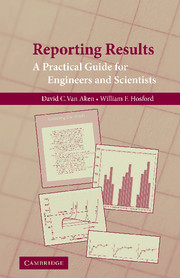Book contents
- Frontmatter
- Contents
- Preface
- REPORTING RESULTS
- 1 Elements of Technical Writing
- 2 Technical Papers
- 3 Technical Letters
- 4 Oral Presentations
- 5 Presentation of Technical Data
- 6 Statistical Analysis of Experimental Data
- 7 Resumé Writing
- Appendix I COMMON ERRORS IN WRITING
- Appendix II PUNCTUATION
- Appendix III COMMON WORD ERRORS
- Appendix IV INTERNATIONAL SYSTEM OF PREFIXES AND UNITS
- Appendix V THE GREEK ALPHABET AND TYPICAL USES
- Appendix VI STRAIGHT-LINE PLOTS FOR SOME MATHEMATICAL FUNCTIONS
- References
- Index
7 - Resumé Writing
Published online by Cambridge University Press: 05 September 2012
- Frontmatter
- Contents
- Preface
- REPORTING RESULTS
- 1 Elements of Technical Writing
- 2 Technical Papers
- 3 Technical Letters
- 4 Oral Presentations
- 5 Presentation of Technical Data
- 6 Statistical Analysis of Experimental Data
- 7 Resumé Writing
- Appendix I COMMON ERRORS IN WRITING
- Appendix II PUNCTUATION
- Appendix III COMMON WORD ERRORS
- Appendix IV INTERNATIONAL SYSTEM OF PREFIXES AND UNITS
- Appendix V THE GREEK ALPHABET AND TYPICAL USES
- Appendix VI STRAIGHT-LINE PLOTS FOR SOME MATHEMATICAL FUNCTIONS
- References
- Index
Summary
The purpose of a resumé is to obtain a job. Only a small fraction of resumés result in job interviews. The reader of resumés spends an average of 30 seconds on each one. To be successful, a resumé should be short, with the important information listed first. It should be well organized and neat. Often a resumé is tailored to a specific job, which would require rewriting the resumé for each new position.
Organization
The first step is to gather the pertinent information and organize it. Then this information should be divided into headings such as Personal Information, Work Experience, Education, Skills, Honors, and Activities.
Personal Information
The person's name, without titles, should appear at the top of the page in a larger font than the rest of the document; use this larger size type for the headings as well. Next list home address, phone numbers, email address, and fax number (if applicable). Citizenship may be listed, but this is not required. Personal information such as age, sex, and general health need not be listed either.
Work Experience
Experience includes full-time and part-time jobs, internships, academic research positions, and volunteer work. List the employer, with months and years worked, position title, and responsibilities. For example, Sam's Café, September 2005 to June 2006, waiter or ABC Chemicals, June to August 2005, summer intern, preparing special orders. Jobs should be listed in reverse chronological order, with the most recent first.
- Type
- Chapter
- Information
- Reporting ResultsA Practical Guide for Engineers and Scientists, pp. 111 - 120Publisher: Cambridge University PressPrint publication year: 2008



